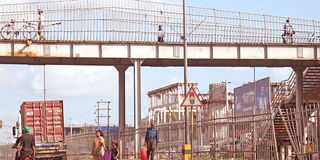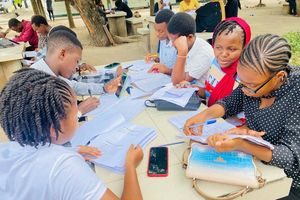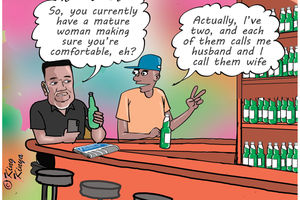How Dar pedestrian bridges save lives despite setbacks

What you need to know:
- According to statistics from the Tanzania Traffic Police Unit, three out of ten people who died in road crashes between 2013 and 2018 were pedestrians.
Dar es Salaam. Although the pedestrian bridges built in the crash-prone areas of Dar es Salaam have reduced road traffic incidents by over 50 percent, there are still challenges in their usage, and some areas still need such bridges.
According to statistics from the Tanzania Traffic Police Unit, three out of ten people who died in road crashes between 2013 and 2018 were pedestrians.
These alarming figures led to the construction of pedestrian bridges in various areas of Dar es Salaam.
“These bridges were built in critical areas to help pedestrians cross safely and reduce congestion. They were constructed following our recommendations and have reduced accidents by at least 50 percent,” says Edwin Mtenga, an officer from the Road Safety Education Unit at the Dar es Salaam Traffic Police Headquarters.
A survey in some areas with pedestrian bridges in Dar es Salaam confirms that road crashes have decreased. From January to September this year, there were only five incidents in the Buguruni area, compared to 12 last year.
The Chairman of the local government in Buguruni notes a reduction of around 20 to 40 crashes annually, a drop of at least 70 percent.
However, in areas like Buguruni, Mbagala, Manzese, and Mbezi Mwisho, some pedestrians still risk crossing the road without using the bridges, which leads to crashes.
Meanwhile, Status report on road safety in the WHO African Region 2023, launched in July 2024 in Nairobi, Kenya, noted that "The African region has the highest percentage of pedestrian fatalities, accounting for one-third of all road accident deaths globally."
Challenges
In Manzese, Ally Kambare, a road crash victim, explains how he was hit by a motorcycle while crossing the road, which has a pedestrian bridge.
Speaking on October 1, 2024, just four days after being discharged from hospital, he describes his ordeal: "I was going to eat at 9pm, I crossed the first lane, but when I reached the second, a motorcycle hit me, and I was rushed to hospital".
The crash left him with a broken leg and head injuries, keeping him out of work for three months now. He emphasises that the incident could have been avoided had he used the pedestrian bridge, urging the government to continue educating people on the importance of using these bridges. He admitted that he didn’t use the bridge because it was late and he was in a hurry.
Research by the National Institute of Transport (NIT), the Karolinska Institute, and Muhimbili University of Health and Allied Sciences (MUHAS) found that while many people understand the importance of pedestrian bridges, they avoid using them at night due to safety concerns like thefts.
Others avoid the bridges due to exhaustion or fear of the height.
Despite these challenges, pedestrian bridges have significantly reduced crashes.
However, improvements are still needed, such as better lighting, enhanced security, and more user-friendly designs to encourage their use.
Public perception
The presence of pedestrian bridges has relieved parents, ensuring the safety of their children who must cross busy roads on their way to and from school.
Rehema Mapande, a resident of Mbagala, highlights this: “Before, we either had to wait to cross with the children ourselves or rely on adults to help them. The bridge has made it safer for them to cross.”
However, some people view the bridges as an inconvenience. Juma Msafiri, who runs a food business near one of the bridges, complains that the bridges are too long, causing people to opt for the more dangerous option of crossing the road directly.
"The bridge is too long, so people find it easier just to cross the road, even though it’s risky," says Msafiri.
On the other hand, Nas Everist, a motorcycle taxi driver near the Mbagala bridge, insists that it’s better to take a longer route and stay safe. "What’s better? Crossing the road, getting hit, or using the bridge and staying safe?"
Another motorcycle driver, Shaibu Beya, points out that some pedestrians deliberately bypass the bridge, squeezing through gaps in the fencing to cross the road. This laziness can lead to crashes.
Despite the complaints, many locals agree that pedestrian road crashes have dropped since the bridges were built. Everist observes that fewer people are being hit while crossing the road to go to the market.
Nevertheless, Lilian Patrick raises concerns about pregnant women's difficulty when using the bridges. "It’s hard for pregnant women to climb the bridges, so they often choose to cross the road," she says, suggesting special arrangements for vulnerable groups. Patrick also admits that the bridge has significantly reduced crashes in the area.
Crime concerns
Bodaboda driver Hamisi Ally, stationed at the Buguruni Bridge, highlights a different issue: The bridge has become a hideout for criminals. "It’s a pedestrian bridge, but you’ll find people just sitting there at night, not doing anything but robbing people," he says.
However, the local government has taken steps to address this issue. According to Hamisi, the local authorities have assigned motorcycle drivers to keep the area safe. "We, the bodaboda riders, have been tasked with guarding this area, and crime has decreased significantly."
While the number of crashes has reduced, Hamisi emphasises that some pedestrians still choose to cross the road rather than use the bridge, leading to occasional road accidents.
Govt and police response
Godfrey Malinda, a local government representative in Maruzuku, Buguruni, confirms that many crashes involved students before the bridge was built.
Regarding crime, he states, "We have put in place collaborative security measures, especially during holidays, to arrest loiterers."
Police officer Edwin Mtenga adds, "We identified these areas as dangerous before the bridges were built. There were many incidents of pedestrians being hit by vehicles or motorcycles. The construction of these bridges has helped reduce such incidents."
However, Mtenga acknowledges that some pedestrians still bypass the bridges, but the police continue educating the public on the importance of using them.
Areas in need of pedestrian bridges
Daniel Mgala, a businessman from Gongolamboto, an area notorious for traffic congestion and frequent pedestrian crashes, advocates a pedestrian bridge, even though it might inconvenience local businesses.
“In this area, we need a bridge. Even though we might suffer as traders, it would reduce crashes," Mgala explains.
Police officer Mtenga notes that no new areas have been recommended for pedestrian bridges, as ongoing projects will determine the construction of any new bridges.




